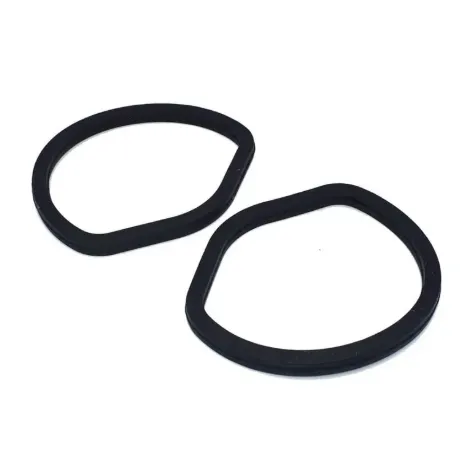Sealing the Foundation: A Complete Guide to Engine and Transmission Pan Gaskets
Modern vehicles depend on a complex network of fluids to lubricate, cool, and protect internal components. At the heart of this system lie the engine oil pan and transmission pan—two reservoirs that hold vital fluids. These components, however, would be useless without the proper sealing power of gaskets. Essential parts like the oil sump gasket, transmission oil pan gasket, oil pan drain plug gasket, oil pan plug gasket, and pan gasket all work together to prevent leaks and keep your vehicle operating safely and efficiently.

While gaskets are often overlooked, failing to replace or maintain them can lead to oil leaks, fluid loss, overheating, and expensive engine or transmission repairs. Let’s explore what each of these gaskets does and why they deserve your attention during routine maintenance.
Engine Oil Pan Seals: Small Gaskets, Big Protection
The oil pan is located at the base of the engine and stores the engine’s oil when it’s not circulating. It’s sealed to the engine block with the oil sump gasket, and the plug that allows you to drain old oil is sealed with either an oil pan drain plug gasket or an oil pan plug gasket.
Oil Sump Gasket
Also referred to as the oil pan gasket, the oil sump gasket is typically made from rubber, cork, or a silicone-based material. It seals the joint between the engine block and the oil sump (or pan), preventing oil from leaking as it sits in the reservoir.
Signs of a worn oil sump gasket include:
Oil leaks forming under the engine
Visible oil residue along the oil pan edges
A slow drop in oil levels without external signs of consumption
Replacing this gasket usually requires removing the oil pan, cleaning both surfaces, and installing a new gasket with proper torque. It’s often done during larger services like timing chain replacement or engine rebuilds.
Oil Pan Drain Plug Gasket / Oil Pan Plug Gasket
Each time you change your oil, you remove the oil drain plug. To prevent oil from seeping around this plug, most vehicles use a oil pan drain plug gasket or oil pan plug gasket—a small, but critical component.
These gaskets are usually made of:
Aluminum
Copper
Nylon or fiber
Failing to replace this gasket during an oil change can lead to:
Minor but consistent oil drips
Difficulty maintaining oil pressure
Dirty oil stains under the vehicle
Fortunately, these gaskets are inexpensive and simple to replace. Many mechanics recommend installing a new oil pan drain plug gasket with every oil change to avoid leaks and maintain a tight seal.
Transmission Pan Seals: Keeping Fluid Where It Belongs
Just as the engine has an oil pan, the automatic transmission has a transmission pan, which houses and cools the transmission fluid. The seal between this pan and the transmission body is handled by the transmission oil pan gasket—a crucial part of your drivetrain system.
Transmission Oil Pan Gasket
The transmission oil pan gasket keeps fluid from leaking out of the pan and contaminating surrounding components. Automatic transmission fluid (ATF) not only lubricates but also transmits power, so losing even a small amount can drastically affect performance.
Symptoms of a failing transmission oil pan gasket include:
Pink or red fluid under the car
Slipping gears or delayed shifts
Low transmission fluid levels despite no visible damage
Burning smell from ATF contacting hot components
Transmission pan gaskets are often made from rubber or cork, though some newer models use reusable silicone gaskets or factory-sealed metal pans. Whenever replacing the gasket, it's a good time to also replace the transmission filter and refill with fresh fluid.
Gasket Maintenance Tips: Preventing Leaks and Long-Term Damage
Whether it’s a pan gasket for the engine or transmission, or a small oil pan plug gasket, every gasket must be installed and maintained properly. Here are some best practices:
Always clean the surfaces: Any dirt or leftover gasket material can prevent a proper seal.
Use a torque wrench: Over-tightening can warp the pan and damage the gasket.
Inspect during oil changes: Look for signs of leaks or buildup around gaskets.
Replace with quality parts: OEM or high-quality aftermarket gaskets reduce the risk of failure.
Consider gasket materials: Rubber is flexible, cork absorbs vibration, and metal-core gaskets can often be reused.
Failing to properly maintain a oil sump gasket or transmission oil pan gasket can cause low fluid levels that lead to severe engine or transmission damage. Small gaskets like the oil pan drain plug gasket may seem minor, but they’re just as essential for clean operation.
From the broad sealing surface of the oil sump gasket to the small but mighty oil pan plug gasket, these components form the foundation of your engine and transmission’s sealing system. Maintaining them is crucial not just for cleanliness, but for performance, longevity, and safety.
Regular inspections, using the right materials, and proactive replacement during oil or transmission fluid changes will ensure your vehicle remains leak-free and fully protected.
-
High-Quality Seal 12x22x5 for Industrial & Automotive Use | YJM Seal
Nkhani Nov.25,2025
-
Seal 12x20x5: Precision Radial Shaft Seals for Industrial Reliability
Nkhani Nov.24,2025
-
Seal 12x18x5: Essential Guide to Specifications, Applications & Vendors
Nkhani Nov.24,2025
-
Understanding Seal 12 20 5: Applications, Specifications & Industry Insights
Nkhani Nov.23,2025
-
Durable Oil Seal 85x110x12 – Reliable Sealing Solutions for Industry
Nkhani Nov.23,2025
-
Durable and Precise Oil Seal 75x95x10 for Efficient Machinery | YJM Seal
Nkhani Nov.22,2025
-
Durable Oil Seal 75x100x10 for Reliable Industrial Performance | YJM Seal
Nkhani Nov.22,2025
Magulu azinthu















